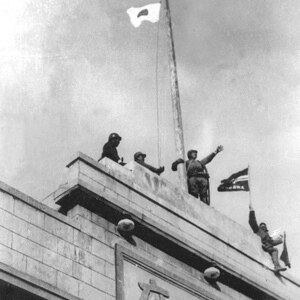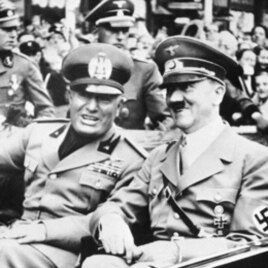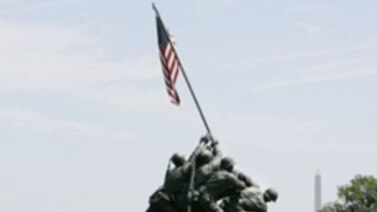
STEVE EMBER: Welcome to THE MAKING OF A NATION – American history in VOA Special English. I’m Steve Ember.
(MUSIC)
In recent programs, we talked about how the rise of Fascist leaders in Europe threatened American neutrality in the nineteen thirties.
(SOUND: Adolf Hitler)
Adolf Hitler and the Nazi party in Germany created the most obvious threat. But there was also Benito Mussolini in Italy and Francisco Franco in Spain. These leaders challenged both the idea of democracy and the security of some of America's closest allies.
Hitler's invasion of Poland and the spread of war in Europe in nineteen thirty-nine made Americans wonder if they could remain neutral much longer.

The United States would finally go to war against Hitler and the other Axis nations. But its first battle would not be in Europe at all. Instead, the United States would enter World War Two following a surprise attack by Japan on the large American naval base at Pearl Harbor, Hawaii.
Relations between the United States and Japan had grown steadily worse throughout the nineteen thirties. Both nations were important industrial powers. But they had very different ideas about the economic and political future of East Asia, especially China.
(MUSIC)
Until the late eighteen hundreds, Japan had been a nation with ancient political traditions and little contact with the Western world.
Visits by Commodore Matthew Perry and American warships helped open Japan to trade with the United States and other nations in the eighteen fifties. And in the years that followed, Japan took major steps toward becoming a modern industrial nation.
By the nineteen twenties and thirties, Japan was a strong country. But it lacked oil, rubber and other natural resources of its own. For this reason, Japanese political leaders looked with envy at the Dutch, French and British colonies across Southeast Asia and the Pacific. And Japanese business leaders saw huge markets for their products in nearby countries like Korea and China.
Japan's desire to use East Asia to gain natural resources and sell manufactured products was in direct conflict with American plans for Asia. This was especially true concerning China. Washington created an "Open Door" policy toward China. It wanted to keep China's natural resources and markets free from control by Japan or any other nation.
(MUSIC)
For this reason, Americans were very concerned when Japanese forces invaded the Manchuria area of China in nineteen thirty-one. And they watched with great interest the efforts of Chinese leader Chiang Kai-shek to oppose the Japanese invaders.
The United States was also very concerned about protecting its imports of oil, tin and rubber from Southeast Asia. This area of the world was a major supplier of these resources in the nineteen thirties. The Middle East had not yet become a leading producer of oil.
In these ways, the United States and Japan were competing for the same resources and Asian markets. However, there also was a good deal of trade between the two nations. In fact, Japan depended on the United States for most of its metal, copper and oil.
This trade with Tokyo became a major concern for President Franklin Delano Roosevelt and the Congress in nineteen thirty-seven.
(MUSIC)
In the summer of that year, more Japanese troops moved into China. They quickly captured much of the Chinese coast.
Much of the metal, oil, and other materials that Japan used for its war effort in China came from the United States. Americans did not like selling Japan materials to use against China. But the trade was legal because of a nineteen eleven agreement between Tokyo and Washington.
However, the American government told Japan in nineteen thirty-nine that it would end the earlier agreement. It would no longer sell Japan materials that could be used for war.
(MUSIC)
Washington's decision made the Japanese government think again about its expansionist plans. And the announcement a month later of a non-aggression treaty between Germany and the Soviet Union gave Tokyo even more cause for concern. The Soviet Union could be a major opponent of Japanese expansion in East Asia. And it appeared free from the threat of war in Europe.
These two events helped moderates in the Japanese government to gain more influence over foreign policy. A moderate government took power in January nineteen-forty.
However, this period of moderation in Tokyo did not last long.
(MUSIC)
In the spring of nineteen forty, Germany launched its blitzkrieg, or lightning invasion, of Europe. The Nazis captured Denmark, Norway, the Netherlands, Belgium, Luxembourg, and finally France.

Extremists in the Japanese government saw the German victory as their chance to launch their own attack on European colonies in Asia. They quickly began negotiations with Hitler to form a new alliance. And within months, militant leaders overthrew the moderate government in Tokyo.
The new Japanese government was headed by a moderate, Prince Konoye. But the minister of war was an expansionist, General Tojo. Tokyo wasted no time in taking action. It forced France to give Japan permission to occupy northern Indochina. And Tokyo also demanded that Britain close the Burma Road to the Chinese city then known as Chungking.
(SOUND)
The Burma Road was a major route by which the United States was supplying China with munitions as part of the Lend-Lease Act.
These events caused relations between Tokyo and Washington to become even worse.
In the second half of nineteen forty, President Roosevelt banned the export of metal and oil products to Japan. His administration also lent money to China.
(MUSIC)
America began to supply Chiang Kai Shek’s government with a fleet of P-40 fighter airplanes with volunteer pilots, led by Army aviator Claire Chennault, to train Chinese pilots. The squadron became known as the Flying Tigers.
American representatives quietly began to meet with British and Dutch officials, to discuss joint defense plans for possible Japanese attacks in the western Pacific.
Washington and Tokyo held long negotiations in nineteen forty-one. The American officials hoped the negotiations might delay Japan from launching an attack to the south. They also thought that a delay might give more moderate leaders in Japan a chance to gain more influence. And for a time, the American plan worked. Japan did not make new acts of aggression.
(MUSIC)
Again, events in Europe caused this situation to change. Nazi Germany attacked the Soviet Union in the middle of nineteen forty-one. This prevented Moscow from doing any fighting on its eastern borders. So Japanese troops were free to invade southern Indochina.
President Roosevelt reacted to Japan's invasion of Indochina by taking three major steps. First, he took control of all Japanese money in the United States. Second, he brought the armed forces of the Philippines under American command. And, third, he closed the Panama Canal to Japanese shipping.
Once again, a conflict developed between moderates and extremists in the Japanese government.
More moderate leaders such as Prime Minister Konoye urged one more effort to reach an agreement with the United States. But the Japanese army and navy believed that the time had come to go to war to end American and European power in East Asia forever.
Negotiations between Japan and the United States continued through the final months of nineteen forty-one. But the two nations were on the edge of war. They were as close to hostilities as Washington was with the Nazi government in Berlin.
(MUSIC)
American military officials captured secret messages from Japan during this time. They learned that Tokyo was planning an attack of some kind unless the United States suddenly changed its policies. However, the American officials could not discover exactly where or how the attack would be made.
Almost everyone in Washington expected that the Japanese would attack south of Japan. They were wrong. The military leaders in Tokyo were planning a surprise attack on America's main Pacific military base, at Pearl Harbor. That will be our story next week.
(MUSIC)
Our program was written by David Jarmul. You can find our series online with transcripts, MP3s, podcasts and pictures at voaspecialenglish.com. You can also follow us on Facebook and Twitter at VOA Learning English. I’m Steve Ember, inviting you to join us again next week for THE MAKING OF A NATION – American history in VOA Special English.
This was program #190
To find earlier programs, type "Making of a Nation" in quotation marks in the search box at the top of the page
